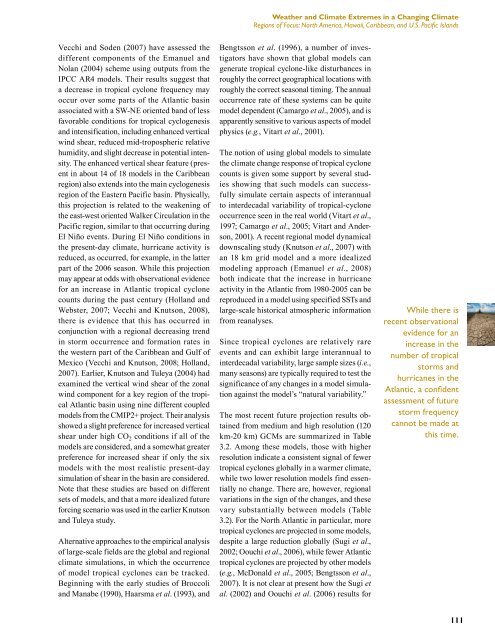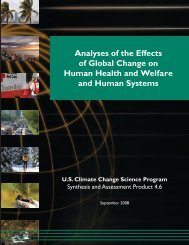Weather and Climate Extremes in a Changing Climate. Regions of ...
Weather and Climate Extremes in a Changing Climate. Regions of ...
Weather and Climate Extremes in a Changing Climate. Regions of ...
Create successful ePaper yourself
Turn your PDF publications into a flip-book with our unique Google optimized e-Paper software.
Vecchi <strong>and</strong> Soden (2007) have assessed the<br />
different components <strong>of</strong> the Emanuel <strong>and</strong><br />
Nolan (2004) scheme us<strong>in</strong>g outputs from the<br />
IPCC AR4 models. Their results suggest that<br />
a decrease <strong>in</strong> tropical cyclone frequency may<br />
occur over some parts <strong>of</strong> the Atlantic bas<strong>in</strong><br />
associated with a SW-NE oriented b<strong>and</strong> <strong>of</strong> less<br />
favorable conditions for tropical cyclogenesis<br />
<strong>and</strong> <strong>in</strong>tensification, <strong>in</strong>clud<strong>in</strong>g enhanced vertical<br />
w<strong>in</strong>d shear, reduced mid-tropospheric relative<br />
humidity, <strong>and</strong> slight decrease <strong>in</strong> potential <strong>in</strong>tensity.<br />
The enhanced vertical shear feature (present<br />
<strong>in</strong> about 14 <strong>of</strong> 18 models <strong>in</strong> the Caribbean<br />
region) also extends <strong>in</strong>to the ma<strong>in</strong> cyclogenesis<br />
region <strong>of</strong> the Eastern Pacific bas<strong>in</strong>. Physically,<br />
this projection is related to the weaken<strong>in</strong>g <strong>of</strong><br />
the east-west oriented Walker Circulation <strong>in</strong> the<br />
Pacific region, similar to that occurr<strong>in</strong>g dur<strong>in</strong>g<br />
El Niño events. Dur<strong>in</strong>g El Niño conditions <strong>in</strong><br />
the present-day climate, hurricane activity is<br />
reduced, as occurred, for example, <strong>in</strong> the latter<br />
part <strong>of</strong> the 2006 season. While this projection<br />
may appear at odds with observational evidence<br />
for an <strong>in</strong>crease <strong>in</strong> Atlantic tropical cyclone<br />
counts dur<strong>in</strong>g the past century (Holl<strong>and</strong> <strong>and</strong><br />
Webster, 2007; Vecchi <strong>and</strong> Knutson, 2008),<br />
there is evidence that this has occurred <strong>in</strong><br />
conjunction with a regional decreas<strong>in</strong>g trend<br />
<strong>in</strong> storm occurrence <strong>and</strong> formation rates <strong>in</strong><br />
the western part <strong>of</strong> the Caribbean <strong>and</strong> Gulf <strong>of</strong><br />
Mexico (Vecchi <strong>and</strong> Knutson, 2008; Holl<strong>and</strong>,<br />
2007). Earlier, Knutson <strong>and</strong> Tuleya (2004) had<br />
exam<strong>in</strong>ed the vertical w<strong>in</strong>d shear <strong>of</strong> the zonal<br />
w<strong>in</strong>d component for a key region <strong>of</strong> the tropical<br />
Atlantic bas<strong>in</strong> us<strong>in</strong>g n<strong>in</strong>e different coupled<br />
models from the CMIP2+ project. Their analysis<br />
showed a slight preference for <strong>in</strong>creased vertical<br />
shear under high CO 2 conditions if all <strong>of</strong> the<br />
models are considered, <strong>and</strong> a somewhat greater<br />
preference for <strong>in</strong>creased shear if only the six<br />
models with the most realistic present-day<br />
simulation <strong>of</strong> shear <strong>in</strong> the bas<strong>in</strong> are considered.<br />
Note that these studies are based on different<br />
sets <strong>of</strong> models, <strong>and</strong> that a more idealized future<br />
forc<strong>in</strong>g scenario was used <strong>in</strong> the earlier Knutson<br />
<strong>and</strong> Tuleya study.<br />
Alternative approaches to the empirical analysis<br />
<strong>of</strong> large-scale fields are the global <strong>and</strong> regional<br />
climate simulations, <strong>in</strong> which the occurrence<br />
<strong>of</strong> model tropical cyclones can be tracked.<br />
Beg<strong>in</strong>n<strong>in</strong>g with the early studies <strong>of</strong> Broccoli<br />
<strong>and</strong> Manabe (1990), Haarsma et al. (1993), <strong>and</strong><br />
<strong>Weather</strong> <strong>and</strong> <strong>Climate</strong> <strong>Extremes</strong> <strong>in</strong> a Chang<strong>in</strong>g <strong>Climate</strong><br />
<strong>Regions</strong> <strong>of</strong> Focus: North America, Hawaii, Caribbean, <strong>and</strong> U.S. Pacific Isl<strong>and</strong>s<br />
Bengtsson et al. (1996), a number <strong>of</strong> <strong>in</strong>vestigators<br />
have shown that global models can<br />
generate tropical cyclone-like disturbances <strong>in</strong><br />
roughly the correct geographical locations with<br />
roughly the correct seasonal tim<strong>in</strong>g. The annual<br />
occurrence rate <strong>of</strong> these systems can be quite<br />
model dependent (Camargo et al., 2005), <strong>and</strong> is<br />
apparently sensitive to various aspects <strong>of</strong> model<br />
physics (e.g., Vitart et al., 2001).<br />
The notion <strong>of</strong> us<strong>in</strong>g global models to simulate<br />
the climate change response <strong>of</strong> tropical cyclone<br />
counts is given some support by several studies<br />
show<strong>in</strong>g that such models can successfully<br />
simulate certa<strong>in</strong> aspects <strong>of</strong> <strong>in</strong>terannual<br />
to <strong>in</strong>terdecadal variability <strong>of</strong> tropical-cyclone<br />
occurrence seen <strong>in</strong> the real world (Vitart et al.,<br />
1997; Camargo et al., 2005; Vitart <strong>and</strong> Anderson,<br />
2001). A recent regional model dynamical<br />
downscal<strong>in</strong>g study (Knutson et al., 2007) with<br />
an 18 km grid model <strong>and</strong> a more idealized<br />
model<strong>in</strong>g approach (Emanuel et al., 2008)<br />
both <strong>in</strong>dicate that the <strong>in</strong>crease <strong>in</strong> hurricane<br />
activity <strong>in</strong> the Atlantic from 1980-2005 can be<br />
reproduced <strong>in</strong> a model us<strong>in</strong>g specified SSTs <strong>and</strong><br />
large-scale historical atmospheric <strong>in</strong>formation<br />
from reanalyses.<br />
S<strong>in</strong>ce tropical cyclones are relatively rare<br />
events <strong>and</strong> can exhibit large <strong>in</strong>terannual to<br />
<strong>in</strong>terdecadal variability, large sample sizes (i.e.,<br />
many seasons) are typically required to test the<br />
significance <strong>of</strong> any changes <strong>in</strong> a model simulation<br />
aga<strong>in</strong>st the model’s “natural variability.”<br />
The most recent future projection results obta<strong>in</strong>ed<br />
from medium <strong>and</strong> high resolution (120<br />
km-20 km) GCMs are summarized <strong>in</strong> Table<br />
3.2. Among these models, those with higher<br />
resolution <strong>in</strong>dicate a consistent signal <strong>of</strong> fewer<br />
tropical cyclones globally <strong>in</strong> a warmer climate,<br />
while two lower resolution models f<strong>in</strong>d essentially<br />
no change. There are, however, regional<br />
variations <strong>in</strong> the sign <strong>of</strong> the changes, <strong>and</strong> these<br />
vary substantially between models (Table<br />
3.2). For the North Atlantic <strong>in</strong> particular, more<br />
tropical cyclones are projected <strong>in</strong> some models,<br />
despite a large reduction globally (Sugi et al.,<br />
2002; Oouchi et al., 2006), while fewer Atlantic<br />
tropical cyclones are projected by other models<br />
(e.g., McDonald et al., 2005; Bengtsson et al.,<br />
2007). It is not clear at present how the Sugi et<br />
al. (2002) <strong>and</strong> Oouchi et al. (2006) results for<br />
While there is<br />
recent observational<br />
evidence for an<br />
<strong>in</strong>crease <strong>in</strong> the<br />
number <strong>of</strong> tropical<br />
storms <strong>and</strong><br />
hurricanes <strong>in</strong> the<br />
Atlantic, a confident<br />
assessment <strong>of</strong> future<br />
storm frequency<br />
cannot be made at<br />
this time.<br />
111




